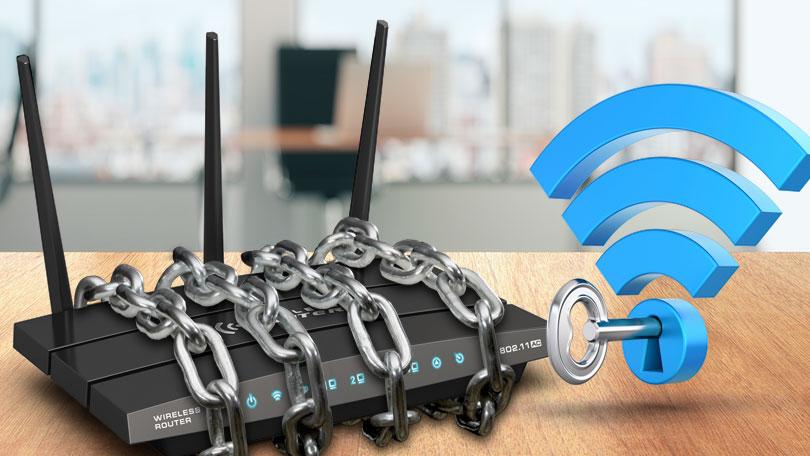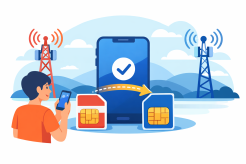Keep Your Home Wi-Fi Safe in 4 Simple Steps

While you may believe that accessing the internet from the comfort of your own house is safe, you could be a victim of hackers if you don't have sufficient internet home protection.
An unsecured internet connection is like leaving the front door wide open for hackers, snoopers, and other people with evil intent to spy on your activities and steal your personal information, even though your doors and windows are locked.
Fortunately, there are actions you can do to protect your data and build up a secure network. We'll walk you through the process of enhancing your home internet security, from how to update your security settings to how to implement new security measures. We'll walk you through how to improve your home internet security, from adjusting router security settings and adding extra protection to altering your MAC and IP addresses and creating a VLAN to safeguard all of your internet-connected equipment.
Make sure your router is secure
Your router serves as an internet gateway. It can also be a hacker's entryway to your network and personal information if left unattended. There are a few basic actions you can take to ensure that your router is as safe as possible and that your home network is not easily accessible to anyone who does not have the authorization to access it.
To begin, change the default name of your home network, which is a fairly simple way to safeguard your router. The Service Set Identifier, or SSID, is the name of your network. When you look at the list of available networks to join, this is what you see. Often, your router's default network name contains information that a hacker can use to learn more about your router. They can determine what type of router you're using based on the SSID and exploit any security flaws in the device. This information is obscured simply by altering the name of your network.
The next step is to create a strong password to protect your network. Use a different password than the one provided by your router. This is frequently a generic password that can be found online. Anyone who knows or can search up your router type can find out how to get onto your network if you don't change the password. Use a strong password or passphrase to prevent others from guessing your password or brute-forcing their way into your network.
VPNs, or virtual private networks, are another effective technique for data security. A VPN establishes a secure and encrypted connection between your device and a server. That server talks with the internet, sending and receiving data on your behalf. However, because all of that data is transferred over a secure connection, no one can see it – even if they are connected to your wireless network. There are several excellent VPN companies to choose from, but we recommend Express VPN.
Finally, make sure your firmware is always up to date. This is a simple but crucial step.
You could also change the IP address of your router. IP addresses are permanent and serve as a device identifier. This information could be used by an attacker to target your router for a distributed denial-of-service assault, which could bring your network down. In your router's settings, you should be able to alter your IP address.
Get Third Party Protection
After you've protected your router, you should think about adding third-party protection to keep hostile actors out of your network. A firewall is an excellent tool for further securing your home internet connection.
Firewalls are relatively simple devices. They're a type of network security gadget that keeps track of all the data that passes across your network. Firewalls use a set of criteria to detect if the data is authentic or potentially dangerous. The firewall will prevent potentially hazardous data packets from reaching your device if it detects them.
Firmware upgrades are issued by device manufacturers in order to address any security flaws that have been detected. If a firmware update for your router becomes available, installing it will prevent a hacker from attacking your router or infecting your network with a virus using a known exploit.
Use a MAC address
While firewalls and VPNs are useful security tools, you may also ban specific devices from connecting to your wireless network directly. You may achieve this by filtering out the MAC address of a device.
A device's unique identity is its MAC address, which stands for Media Access Control (MAC) address. A MAC address, unlike an IP address, is fixed and cannot be modified. That implies that if you know the MAC address of a device you want to restrict from connecting to your Wi-Fi, you can successfully prevent it from joining to your connection without your authorization.
MAC filtering, which uses MAC addresses to assist manage who can access your network, is available on most routers. A blacklist can be used to block specific MAC addresses from all connections. You can also employ a whitelist, which will only allow connections from permitted addresses. This can severely limit access to your network and make it impossible for any hostile actors to connect.
For IoT devices, use a VLAN
While your router and primary devices are probably safe, the Internet of Things (IoT) has introduced a whole new level of security risk. All of your internet-connected gadgets provide additional entry points for attackers to gain access to your network and data.
This includes everything from smart home gadgets like an internet-connected refrigerator or light bulbs to smartwatches and smart speakers.
Every one of these gadgets is connected to the internet through your home network, and they represent a new attack vector for hackers. Because some IoT devices are less secure than others, hackers can take advantage of these flaws to get access to your network via the devices rather than attacking or connecting to your Wi-Fi directly.
Consider establishing a Virtual Local Area Network, or VLAN, to protect against these attacks. A VLAN is a subnetwork that is separate from the one to which you connect to access the internet. Because all devices linked to the VLAN are partitioned together, your entire network is not at risk if one is compromised.
Related Posts

Tue, Jan 13, 2026 9:36 PM
cheap internet dealsHow Long Does It Take to Switch Phone Carriers?
Learn how long it takes to switch phone carriers, including number porting, plan selection, and tips for a seamless transition to better service and savings.

Tue, Jan 13, 2026 9:03 PM
TechnologyHow eSIM Helps You Stay Connected While Traveling Abroad
Discover how eSIM helps travelers stay connected abroad with instant activation, cost-effective plans, and reliable mobile data for seamless international travel.

Mon, Jan 12, 2026 11:04 PM
SubscriptionHow to Use Your Cell Phone Internationally Without Breaking the Bank
Learn how to use your cell phone internationally with data plans, local SIMs, and Wi-Fi tips to stay connected without high roaming fees.

Mon, Jan 12, 2026 10:51 PM
WifiHow RCS Works: The Future of Messaging on Your Phone
Learn how modern messaging works and why it’s the future of texting with high-quality media, read receipts, and interactive group messaging.

Fri, Jan 9, 2026 3:20 AM
RegulationsWhy Apps Keep Using Your Data in the Background (And How to Stop It)
Learn why apps keep using data in the background, how it affects your data cap, and simple ways to reduce background data usage without losing functionality.